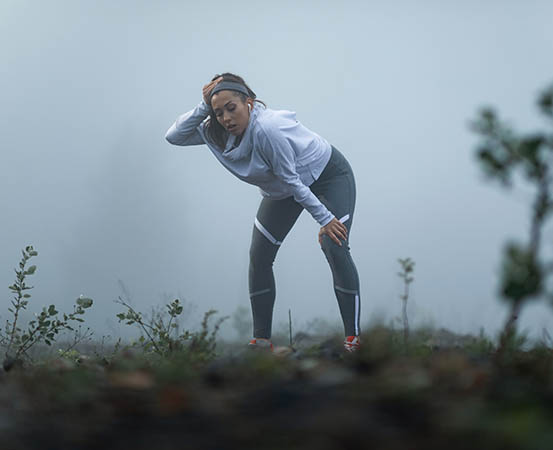Low temperatures constrict the muscles, tendons and ligaments, aggravating pain and causing discomfort. Staying hydrated and being physically active can help
Written By Neha Jain
With Quotes from Dr Ramkinkar Jha (orthopedist), Dr Darshan Angadi (orthopedic surgeon)
As the temperatures dip during winter, most limit their physical activities, preferring to stay indoors, cocooned in the warm confines of home. However, limiting physical activities is one of the main reasons why muscle weakness and joint pain start to set in during this season.
People with issues such as arthritis experience an increase in pain during winter. This is due to weather-induced inflammation. However, there are ways to counter the impact of cold weather on joints and muscles, say experts.
What causes joint pain during winter?
The cold weather causes the muscles, tendons and ligaments to contract, reducing their flexibility. This results in stiffness and discomfort. Some other important factors that exacerbate joint pain during winter include:
♦ Accumulation of synovial fluid: Due to limited physical activities, the synovial fluid (a thick, viscous fluid that lubricates the joints) accumulates in the joints. This aggravates pain; in addition, muscle weakness sets in.
“Whenever the temperature drops, the blood circulation to the joints gets reduced,” says Dr Darshan Angadi, consultant orthopedic surgeon, Altius Hospitals, Bangalore. “The buildup of metabolites in the synovial fluid leads to tissue inflammation. As a result, the circulation gets sluggish [leading to stiffness and pain].”
♦ Reduced sunlight exposure: Sunlight activates the synthesis of vitamin D in the body. In winter, however, exposure to sunlight is limited. This directly impacts bone health since the sunshine vitamin is important for calcium absorption in the body.
♦ Seasonal affective disorder (SAD): This is a psychological condition observed in people with arthritis and chronic pain during winter. “Whenever the winter sets in, exposure to sunlight is relatively less. It affects one’s mood and makes them unhappy. This has a direct impact on how the neuroreceptors [proteins that are activated by neurotransmitters] perceive pain,” adds Dr Angadi.
♦ Reduced physical activity: “One of the main factors that contribute to muscle stiffness during winter is reduced physical activity. This, in turn, aggravates the pain,” says Dr Ramkinkar Jha, chief and unit head, orthopedics, Artemis Hospitals, Gurugram.
Joint pain in winter: Exercise is the remedy
Activities like swimming, walking and yoga are beneficial, especially for beginners, as they improve joint mobility without putting excessive strain on them. Focusing on strength training targeting the muscles around the joints will help improve their stability. “Exercise stimulates the production of synovial fluid that lubricates the joints, reducing friction and enhancing smoother movement,” informs Dr Jha.
Additionally, exercise boosts blood circulation, delivering nutrients to the joints and helping in the removal of waste products. This, in turn, helps reduce joint pain during winter.
Measures to manage joint pain in winter
- Design an exercise routine and maintain consistency, irrespective of the month or year. “Keep your workout routine going regardless of the outside environment,” advises Dr Angadi.
- It’s important to stay physically active, especially during winter. Joint pain during this season can be kept at bay through activities that help maintain joint flexibility, mobility, strength or endurance. While choosing whatever works for you is ideal, it’s important to stick to that routine. “Physical activity along with exercise programs focused on the affected joints will help,” says Dr Angadi.
- People usually reduce their water intake during winter. This can cause dehydration, affecting cartilage health. “Cartilage consists of about 80 percent water. The supplements that people take to lubricate the joints won’t help if the water intake is reduced. Hence, ensuring adequate hydration is a must,” says Dr Angadi.
- Improving social life will help improve one’s mood, lowering pain and its perception.
- Oil massages are a great way to improve joint mobility. In addition, keeping a warm towel on the joints can help relieve pain and improve circulation, enhancing muscle movement.
Wear warm clothes to ease the pain
Warm clothes provide a protective barrier against the cold weather, preventing tissues from constricting. “Wearing warm clothes provides insulation that helps the body retain its heat, preventing the joints from getting stiff,” says Dr Jha. “This warmth results in improved blood circulation that enhances joint flexibility.” People with ailments like arthritis should maintain an ideal body temperature, which can reduce the symptoms and curb weather-induced inflammation.
Takeaways
- The winter weather causes contractions in the muscles, tendons and ligaments, reducing their flexibility. This results in stiffness and discomfort.
- Joint pain during winter can be managed by wearing warm clothes, exercising regularly and maintaining a healthy lifestyle. These factors improve blood circulation, which in turn enhances flexibility in the muscles and joints.



